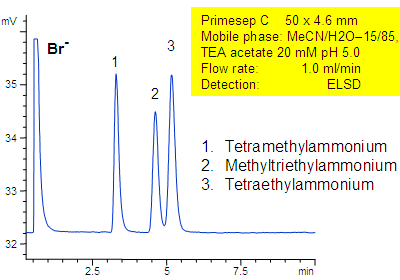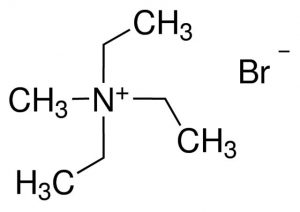| CAS Number | 2700-16-5 |
|---|---|
| Molecular Formula | C7H18BrN |
| Molecular Weight | 196.132 |
| InChI Key | GRVPDGGTLNKOBZ-UHFFFAOYSA-M |
| Synonyms |
|
Applications:
Separation of Quaternary Amines
September 11, 2003

Primesep C separates a mixture of quaternary amines by a combination of cation exchange, complex formation, and hydrophic interactions. Methyltriethylammonium, tetraethylammonium, and tetramethylammonium cations as well as bromide counter ion are separated on a short 50 mm column. The separation uses a mobile phase mixture of water, acetonitrile (MeCN, ACN) and triethylamine acetate with evaporative light scattering detection (ELSD).
| Column | Primesep C, 4.6×50 mm |
| Mobile Phase | MeCN/H2O |
| Buffer | TEA acetate |
| Flow Rate | 1.0 ml/min |
| Detection | ELSD |
| Class of Compounds |
Quaternary Amines, Ionizable, Hormone |
| Analyzing Compounds | Methyltriethylammonium, tetraethylammonium, Tetramethylammonium |
Application Column
Primesep C
The Primesep family of mixed-mode columns offers a wide variety of stationary phases, boasting unprecedented selectivity in the separation of a broad array of chemical compounds across multiple applications. Corresponding Primesep guard columns, available with all stationary phases, do not require holders. SIELC provides a method development service available to all customers. Inquire about our specially-tailored custom LC-phases for specific separations.
Select optionsMethyltriethylammonium Bromide
Quaternary Amines
Tetraethylammonium
Tetramethylammonium



